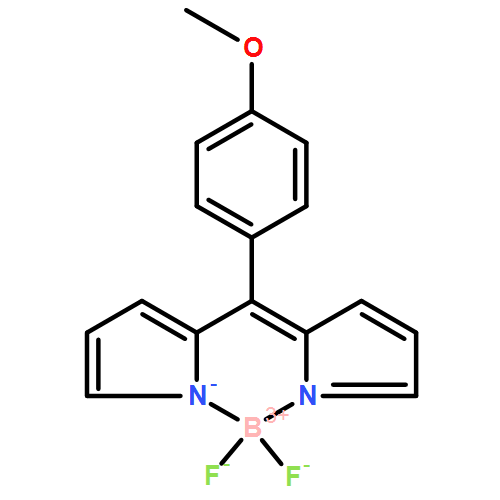Co-reporter: V. Lakshmi and M. Ravikanth
pp: 5903-5911
Publication Date(Web):07 Mar 2012
DOI: 10.1039/C2DT00019A
meso-Anisyl boron dipyrrins (BODIPYs) 1–6 containing one to six bromines at the pyrrole carbons have been synthesized by treating meso-anisyl dipyrromethane with ‘n’ equivalents of N-bromosuccinimide in THF at room temperature followed by oxidation with DDQ, neutralization with triethylamine and further complexation with BF3·OEt2. The brominated compounds were characterized by HR-MS mass, detailed 1H, 19F and 11B NMR and X-ray diffraction studies. The crystal structures solved for compounds 2–6 indicate that the boron dipyrrinato framework comprised two pyrrole rings and one six membered boron containing ring in one plane like other reported BODIPYs. However, the dihedral angle between the BODIPY core and the meso-anisyl group varied from 48° to 88° and the meso-anisyl ring has an almost perpendicular orientation in penta 5 and hexabrominated 6 BODIPYs. The absorption and emission studies showed a bathochromic shift and reached a maximum for tetrabrominated derivative 4, after which there was no change in the peak maxima for penta 5 and hexabrominated 6 derivatives. However, the quantum yields were reduced with the increasing number of bromines. The electrochemical studies revealed that brominated BODIPY compounds 1–6 are easier to reduce compared to unsubstituted meso-anisyl BODIPY 8 and the reduction potential is linearly related to the number of Br groups.
Co-reporter: V. Lakshmi and M. Ravikanth
pp: NaN5911-5911
Publication Date(Web):2012/03/07
DOI: 10.1039/C2DT00019A
meso-Anisyl boron dipyrrins (BODIPYs) 1–6 containing one to six bromines at the pyrrole carbons have been synthesized by treating meso-anisyl dipyrromethane with ‘n’ equivalents of N-bromosuccinimide in THF at room temperature followed by oxidation with DDQ, neutralization with triethylamine and further complexation with BF3·OEt2. The brominated compounds were characterized by HR-MS mass, detailed 1H, 19F and 11B NMR and X-ray diffraction studies. The crystal structures solved for compounds 2–6 indicate that the boron dipyrrinato framework comprised two pyrrole rings and one six membered boron containing ring in one plane like other reported BODIPYs. However, the dihedral angle between the BODIPY core and the meso-anisyl group varied from 48° to 88° and the meso-anisyl ring has an almost perpendicular orientation in penta 5 and hexabrominated 6 BODIPYs. The absorption and emission studies showed a bathochromic shift and reached a maximum for tetrabrominated derivative 4, after which there was no change in the peak maxima for penta 5 and hexabrominated 6 derivatives. However, the quantum yields were reduced with the increasing number of bromines. The electrochemical studies revealed that brominated BODIPY compounds 1–6 are easier to reduce compared to unsubstituted meso-anisyl BODIPY 8 and the reduction potential is linearly related to the number of Br groups.
